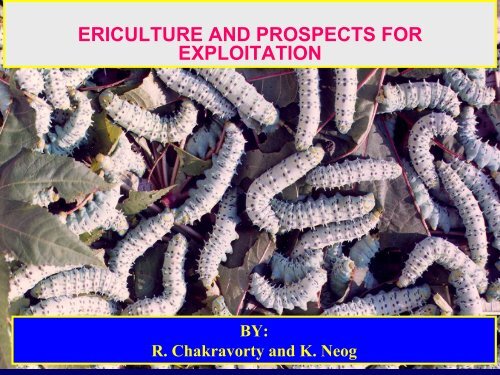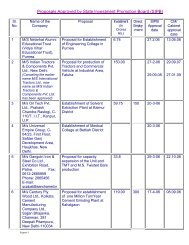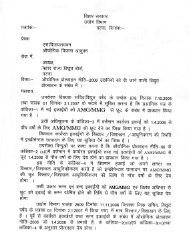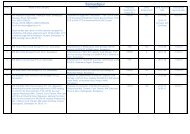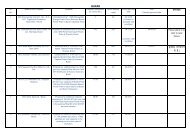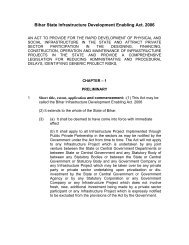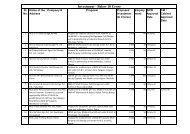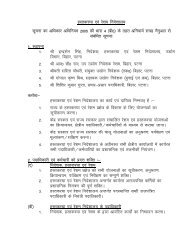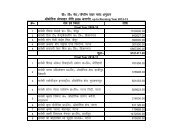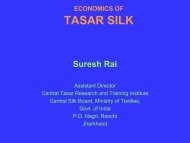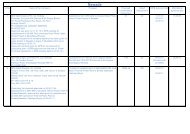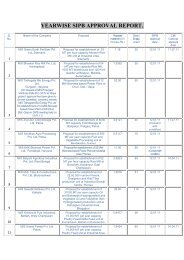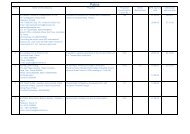Ericulture and Prospects for Exploitation-Presentation at Workshop ...
Ericulture and Prospects for Exploitation-Presentation at Workshop ...
Ericulture and Prospects for Exploitation-Presentation at Workshop ...
Create successful ePaper yourself
Turn your PDF publications into a flip-book with our unique Google optimized e-Paper software.
ERICULTURE AND PROSPECTS FOREXPLOITATIONBY:R. Chakravorty <strong>and</strong> K. Neog
PRODUCTION OF ERI SILKOver the period of last ten years, eri silkproduction increased significantly from 735 MTin 1995-96 to 1079 MT in 2000-2001, further to1417 MT during 2004-05.
PRODUCTION STATISTICS OF ERI SILK DURING LASTDECADEYear Northeastern Other parts of thecountry (MT)St<strong>at</strong>es (MT)1995-96 734.67 10.33 745.00Total production(MT)1996-97 734.67 10.33 745.001997-98 762.47 51.53 814.001998-99 848.09 121.91 970.001999-00 682.56 291.44 974.002000-01 1079.00 10.00 1089.002001-02 1148.00 12.00 1160.002002-03 1300.70 15.30 1316.002003-04 1333.00 19.00 1352.002004-05 1417.00 31.20 1448.20
USES OF ERI‣ Mainly two types of eri products are made in NorthEast, i.e.,‣ Eri-chaddars <strong>for</strong> gents <strong>and</strong>‣ Eri-scarves with small motifs <strong>for</strong> ladies as winterclothing. Eri silk possesses excellent thermalproperties‣ The loose fibers can be used as a filling m<strong>at</strong>erial inquilts <strong>and</strong> winter clothing due to its thermalproperties.
It can be used <strong>for</strong> production of diversified<strong>and</strong> specialized items like:‣ Ladies garments, Chaddars, Dokhanas, skirts,midies,maxis, etc.‣ Children garments.‣ Kurtas, Jackets, etc.‣ Cross stitch <strong>and</strong> embroidery work.‣ Fashion accessories like ties, scarves, stoles,kerchiefs, etc.‣ Bags, wallets, file, folders, etc.
ADVANTAGE OF ERI SILK‣ Traditionally, eri is known <strong>for</strong> simple living <strong>and</strong> used onlyin manufacture of gents chaddars <strong>and</strong> ladies shawls, th<strong>at</strong>too in n<strong>at</strong>ural colour.‣ Besides the traditional shawls we can see stoles,garments, scarf, furnishing m<strong>at</strong>erials of eri in variedcolour combin<strong>at</strong>ions th<strong>at</strong> were not available earlier.‣ Eri crepes using extra twist in both warp <strong>and</strong> weft <strong>and</strong>increasing the shrinkage so th<strong>at</strong> it could well be used<strong>for</strong> modern dresses like ladies skirt etc. by blending itwith other silks <strong>and</strong> n<strong>at</strong>ural fibers like cotton, wool<strong>and</strong> pashmina.‣ Because of its n<strong>at</strong>ural warmth it is user friendly.
BY-PRODUCTS AND ITS UTILITY1. Food plants By-products:‣ The unused leaves <strong>and</strong> branches produced from pruningare utilized as c<strong>at</strong>tle feed, fuel <strong>and</strong> manure.‣ The stem of castor can be used in paper industry.‣ The castor seeds, which contains about 45% of nitrogenin the oil cake, can be used as manure or antidote towhite ants in the field.2. Uses of Eri Silkworm Litter:‣ The litters of eri silkworms can be used as component inproduction of vermi-compost.
BY-PRODUCTS AND ITS UTILITY3. Uses of Pupae:‣ The eri pupa contains 60% crude protein, 25% lipid <strong>and</strong>5-8 % free amino acids <strong>and</strong> it is a delicacy among manytribes of North East India.‣ The pupa oil is used in prepar<strong>at</strong>ion of emulsionsolution in jute industry to make jute fibre soft <strong>for</strong>easy spinning.
ERI SILKWORM AND ITS DIVERSITYThe structure of the genitalia, wing p<strong>at</strong>tern <strong>and</strong>chromosome number demonstr<strong>at</strong>e th<strong>at</strong> Samia ricini(Donovan)(2n=40) is derived from its wild <strong>for</strong>m, Samiacanningi (Hutton).‣ The cultiv<strong>at</strong>ed variety of Samia ricini does not occur inthe wild.‣ The taxonomic position of eri silkworm is as follows.A) Order : LepidopteraB) Family : S<strong>at</strong>urniidae.C) Tribe : AttaciniD) Genus : SamiaE) Species : ricini (Donovan)
STRAINSSix homozygous strains were isol<strong>at</strong>ed on the basis oflarval colour <strong>and</strong> marking,‣ Yellow Plain (YP),‣ Yellow Spotted (YS),‣ Yellow Zebra (YZ),‣ Greenish Blue Plain (GBP)‣ Greenish Blue Spotted (GBS)‣ Greenish Blue Zebra (GBZ).
Yellow plain (YP)Yellow spotted (YS )Geenish blue Zebra
Geenish blue spott(GBS)Greenish blue plain (GBP)Yellow Zebra (YZ)
COCOON CHARACTERS:STRAINS‣ Cocoon colours are white, off-white <strong>and</strong> brick red.‣ White colour cocoon is available in whole North EastIndia.‣ In Kokrajhar of Assam, eri silkworm is rearedexclusively <strong>for</strong> brick red cocoons. Cocoons are ovalin all cases.
Different types of eri cocoons
STRAINSMOTH CHARACTERS‣ Moth colour is variable, but always solidly white onthe dorsal surface of the abdomen.‣ Ground colour was usually light or dark grayishbrown, rarely reddish, but occasionally olive gray.‣ Wing p<strong>at</strong>tern was heavily marked whiter in antemedian <strong>and</strong> post median lines.
Different type of moth of eri silkworm moths
ERI ECORACES AND THEIR FEATURESIn eri silkworm, eight eco-races are known,1. Borduar, 2. Titabar,3. Dhanubhanga, 4. Khanapara,5. Sile, 6. Nongpoh,7. Mendip<strong>at</strong>har <strong>and</strong> 8. Kokrajhar. Among these, Borduar, Titabar <strong>and</strong> Kokrajhar ecoracesare commercially exploited due to their bettereconomic traits. These eco-races are being reared by farmers ofMeghalaya, Assam, Manipur <strong>and</strong> Nagal<strong>and</strong>.
ECO-RACES AND STRAINS OF ERI SILKWORM WITH THEIRCHARACTERSEco-racesLocality/originLarvalcolour(Strains)Fecundity(Nos.)CocooncolourShellwt.(g)SilkYield(%)BorduarBorduar,KamrupYP, YZ,GBP, GBZ465White0.5313.47TitabarTitabar,Jorh<strong>at</strong>YP, YS,GBP,GBS,464OffWhite0.5013.01DhanubhangaDhanubhanga,GoalparaYP, GBP,443White0.4713.24KhanaparaKhanapara,KamrupYP, GBP,461White0.5012.85KokrajharKokrajhar,YP466Brickred0.5114.64SilleSille,ArunachalYP438White0.4612.92NongpohMeghalaya,NongpohYP, GBP448White0.4712.76Mendip<strong>at</strong>harMendip<strong>at</strong>harEast Garo HillsYP, YZ,GBP, GBZ454White0.4612.67
Rearing per<strong>for</strong>mance of different eco-races of eri silkworm(Av. of 7 crops).Eco-racesFecundity(nos.)H<strong>at</strong>ching (%)Larvalweight (g)ERR(%)Av.cocoon wt.(g)Av.shellwt.(g)SilkR<strong>at</strong>io(%)Borduar 433.71 91.34 5.82 88.22 3.54 0.50 14.22Dhanubha 421.57 89.64 5.78 88.26 3.56 0.50 14.26ngaKhanapar 413.00 89.10 5.83 85.28 3.33 0.48 14.22aMendi 436.20 90.33 5.79 87.28 3.37 0.50 15.09LocalNongpoh 425.70 88.69 5.92 86.91 3.43 0.50 14.74Titabar 393.14 89.27 5.61 87.53 3.32 0.48 14.41
Rearing per<strong>for</strong>mance of different strains of eri silkworm(Av. of 5 crops).StrainsFecundity (nos.)H<strong>at</strong>ching (%)Larvalweight (g)ERR(%)Av.cocoon wt.(g)Av.shellwt.(g)SilkR<strong>at</strong>io(%)Y. Plain 452.0 90.17 5.77 79.54 3.42 0.51 14.94Y.Spotted448.20 89.63 5.77 80.18 3.43 0.53 15.35Y. Zebra 440.40 91.34 5.67 80.35 3.30 0.47 14.39G. B.PlainG. B.SpottedG. B.Zebra337.20 90.57 5.65 84.54 3.45 0.510 15.00452.20 89.21 5.53 77.57 3.39 0.54 15.90428.60 90.73 5.56 79.74 3.25 0.46 14.42
ERI SILKWORM SEED PRODUCTIONGrainage Hall:1. Bamboo made house with th<strong>at</strong>ched roof <strong>and</strong> mudplastered wall is preferable <strong>for</strong> grainage in ruralareas. For concrete halls, it should be well ventil<strong>at</strong>ed.2. Size of the hall will depend on the numbers of dfls tobe prepared during a particular period.3. Var<strong>and</strong>a should be provided round the hall <strong>for</strong>keeping temper<strong>at</strong>ure down during summer.
MATERIALS REQUIRED FOR GRAINAGE OPERATIONGrainage Hall:1. Bamboo made house with th<strong>at</strong>ched roof <strong>and</strong> mudplastered wall is preferable <strong>for</strong> grainage in ruralareas. For concrete halls, it should be well ventil<strong>at</strong>ed.2. Size of the hall will depend on the numbers of dfls tobe prepared during a particular period.3. Var<strong>and</strong>a should be provided round the hall <strong>for</strong>keeping temper<strong>at</strong>ure down during summer.
MATERIALS REQUIREDEQUIPMENTS1. Spray machine 2. BOD incub<strong>at</strong>or3. Microscope 4. Micro-slides <strong>and</strong> cover slips5. Moth crushing set 6. Masks <strong>and</strong> gloves7. Moth cage 8. Kharika or netlon pouch9. Foam pad 10. Measuring cylinder11. Balance 12. Muslin cloth13. Scissor 14. Bucket15. ThreadsCHEMICALS1. Formalin 2. Bleaching powder3. Lime powder 3. Potassium hydroxide
DISINFECTION OF GRAINSAGE HALL‣Disinfections should be done 3-4 days prior to consignment ofseed cocoons <strong>and</strong> immedi<strong>at</strong>ely after completion of grainageoper<strong>at</strong>ions.‣Drench the walls of the hall <strong>and</strong> grainage appliances with 5%Bleaching Powder solution.‣Seal the grainage hall air tight <strong>and</strong> put all appliances inside it.‣Prepare fresh disinfectants by mixing 5 g slaked lime/l of 2%Bleaching powder solution.‣Disinfection should be done preferably during a sunny day.‣Spray freshly prepared disinfectants in the grainage hall <strong>and</strong> keepthe room closed <strong>for</strong> 24 hours.‣Amount of disinfectants to be used is 1 litre per 2.5 sq.m floorarea.‣Open the hall one day prior to receipt <strong>and</strong> transfer of seedcocoons into the hall.‣Use masks <strong>and</strong> h<strong>and</strong> gloves during the process
SELECTION, COLLECTION AND TRANSPORTATION OFSEED COCOONS‣Select only compact <strong>and</strong> fully <strong>for</strong>med cocoons <strong>for</strong> seed purpose.‣Be<strong>for</strong>e selection, pupal gut test should be done to pebrinefreeness of the lot.‣Cocoons from the d<strong>at</strong>e of highest worm ripening day arepreferable.‣Transport seed cocoons after complete pup<strong>at</strong>ion avoiding directsunlight, rain, jerk etc.
‣The seed cocoons should be kept in moth cages in single layer tofacilit<strong>at</strong>e proper aer<strong>at</strong>ion <strong>and</strong> <strong>at</strong> temper<strong>at</strong>ure between 26-28 degreeCelsius with RH 80%.‣Moth emergence generally takes place during morning <strong>and</strong>continues till noon.‣Male <strong>and</strong> female moths should be kept in moth cages <strong>at</strong> 1.5:1 r<strong>at</strong>io<strong>for</strong> easy coupling <strong>for</strong> a period of 10 hours.‣Decouple the moths next day morning <strong>and</strong> female moths may betied in kharikas or in netlon pouch.‣First three days laid eggs should be kept <strong>for</strong> rearing.‣The mid gut of the mother moths should be examined to detectpresence of pebrine spores <strong>and</strong> positive moths should be rejected<strong>and</strong> burnt.‣The eggs selected are then should be drenched with soap solutionfollowed by dipping in 2% <strong>for</strong>maldehyde solution <strong>for</strong> three minutes<strong>and</strong> then washing in running w<strong>at</strong>er till smell of <strong>for</strong>maldehyde goesoff.‣Sterilized eggs then should be dried in shade.‣For uni<strong>for</strong>m h<strong>at</strong>ching of eggs, the dfls packed in paper or bambooboxes should be incub<strong>at</strong>ed <strong>at</strong> 26±1º C temper<strong>at</strong>ure <strong>and</strong> 85±5 % RH.
REAING TECHNOLOGY
REARING HOUSE‣ Rearing house should be well aer<strong>at</strong>ed <strong>and</strong> dry.‣ For 100 dfls rearing, size of the rearing house should be16x12x10 ft (LxBxH) with 1.5 m ver<strong>and</strong>ah all around is ideal.DISINFECTION OF REARING HOUSE AND APPLIANCES‣Prior to rearing, rearing house <strong>and</strong> appliances should be sterilizedthoroughly with 5% Bleaching powder solution @ 1 litre per 2.5 sq marea. One kg bleaching powder is required to disinfect the rearinghouse per oper<strong>at</strong>ion.‣Disinfect the rearing house <strong>and</strong> appliances immedi<strong>at</strong>ely aftercompletion of rearing in similar way.REARING APPLIANCES‣‣ Five tier bamboo pl<strong>at</strong><strong>for</strong>m with carrying capacity of 25 dfls i.e. 5dfls in each tier.
FEEDING AND BED CLEANING‣ Newly h<strong>at</strong>ched silkworms should be put to tender leaveswith the help of a fe<strong>at</strong>her or soft hair brush.‣ Provide tender leaves to 1 st <strong>and</strong> 2 nd instar, medium leavesto 3 rd instar <strong>and</strong> m<strong>at</strong>ure leaves to 4 th <strong>and</strong> 5 th instar worms.‣ Daily provide feeding 2 times to 1 st , 2 nd <strong>and</strong> 3 rd <strong>and</strong> 4 timesto 4 th <strong>and</strong> 5 th stage silkworms.‣ For 100 dfls rearing, requirement of leaf is 120 kg <strong>for</strong> I-IIIstage, 120 kg <strong>for</strong> IV stage <strong>and</strong> 960 kg <strong>for</strong> V stage larvae.‣ Clean rearing beds once during 1 st stage, twice during 2 ndstage, thrice during 3 rd stage <strong>and</strong> daily during 4 th <strong>and</strong> 5 th stage.‣ Avoid overcrowding of worms in the rearingtray/pl<strong>at</strong><strong>for</strong>m.
PRECAUTIONS TO BE TAKEN DURINGMOULTING PERIOD‣ Eri silkworm moults four times during its larval life.‣ During moulting period, larvae should not bedisturbed.‣ When more than 80% worms enter moulting, rearingbed should be dusted with slacked lime powder tokeep the rearing tray/pl<strong>at</strong><strong>for</strong>m dry.‣ When 90% worms complete moulting, resumefeeding.
SPINNING OF WORMS AND HARVESTING OFCOCOONS‣ Bamboo ch<strong>and</strong>raki, bamboo strip mountage <strong>and</strong>collapsible plastic mountages are found most suitable <strong>for</strong>cocooning of eri silkworm.‣ Ensure well aer<strong>at</strong>ion in the cocooning hall.‣ Harvest cocoons from the mountage after 5 days ofcocooning during summer <strong>and</strong> after 8 days during winter.
ADVANTAGE OVER EXISTINGPROCESSES/ PRODUCTS‣ NBR-1 variety of castor with recommended packageof practices ensures 12 MT leaf yield per hectare asagainst 8 MT yield <strong>at</strong> farmers level which amounts to33.3% gain.‣ It enhances the carrying capacity per hectare from667 dfls to 1000 dfls per year.‣ Recommended Borduar <strong>and</strong> Titabor eco-races of erisilkworm have higher potential in respect of fecundity(Av.400 nos.) <strong>and</strong> shell weight (Av. 0.38g).
HOST PLANTS OF ERI SILKWORM
1.CASTOR (Ricinus communis)It is an evergreen, bush orsmall tree, shoots <strong>and</strong> paniclesglaucous, leaves green, 30-45cm diameter, membranous,lobes from oblong to linearacute, gl<strong>and</strong> serr<strong>at</strong>ed, petiole12-30 cm., racemes stout,erect, male flower 1.5 cm indiameter, female calyx nearlyoblong, styles often highlycoloured, capsules 1.5 to 3.0cm, long globosely oblong,smooth or echin<strong>at</strong>e, seedsoblong, smooth <strong>and</strong> mottled.
METHOD OF PROPAGATIONCastor is grown generally through seeds, which aresown during March-April <strong>and</strong> September-October inNE India.Perennial varieties are recommended to be sown <strong>at</strong> aspacing of 1 X 1.5 meter spacing while annual in 1 X 1meter spacing.Both pit <strong>and</strong> furrow method of planting could beadopted <strong>for</strong> castor cultiv<strong>at</strong>ion .
VARIETIES OF CASTORThere are several varieties of castor available in India.NBR-1, local green, local pink, 48-1 Varieties of castorshowed better per<strong>for</strong>mance in leaf yield <strong>and</strong> silkwormrearing in N.E. India.Some other varieties grown <strong>for</strong> eri silkworm rearingare, 12B Hardasbigha, Damalgiri, T-3, Hojai, LocalRed -Powdery, Dharmanagarpur, RG-885 <strong>and</strong> RG-919,etc.The ruling castor varieties/hybrids <strong>for</strong> seedproduction in India are Co-1, Jyothi, Kranthi, Aruna,Bhagya, GCH-4, DCH-32, DCH-177, Gauch-1 etc.
VARIETIES OF CASTORTen promising castor varieties have been identifiedsuitable <strong>for</strong> eri silkworm rearing viz.,i) Local Green, II. 12B Hardasbigha,iii) Damalgiri,iv) T-3,v) Local Red - Non-powdery (NBR-1), vi) Hojai,vii) Local Red -Powdery, viii) Dharmanagarpur,ix) RG-885 <strong>and</strong> x) RG-919.Among these, NBR-1 is proved to be the best per<strong>for</strong>mer.
BIOMASS YIELD PER UNIT AREAHigh yielding varieties of castor have the potentiality ofproducing 10-12 t leaf/ha/year.In addition, it could also produce 2-4 quintals of seedsper hectare in a year.November (3000kg/ha) <strong>and</strong> 4) February-March (2500Under NE condition, from castor plant<strong>at</strong>ion, four leafharvests can be made in a year during 1) May (3500kg/ha), 2) July-August (3000kg/ha), 3) Octoberkg/ha).NBR-1 variety of castor with recommended package ofpractices ensures 12 MT leaf yield per hectare asagainst 8 MT yield <strong>at</strong> farmers level which amounts to33.3% gain.It enhances the carrying capacity per hectare from 667dfls to 1000 dfls per year.
TAPIOCA OR CASSAVA: MANIHOTESCULENTA‣Tapioca is a perennial shrub withvariously branched stems growing to aheight of 3-4 meters <strong>and</strong> producesenlarged tuberous roots.‣It grows best in warm <strong>and</strong> humidclim<strong>at</strong>e, soils of all types except insaline or alkaline having pH within 5.5to 7.0, but could not withst<strong>and</strong> w<strong>at</strong>erlogging.‣The leaves of this plant are very largewith long petioles, having 5-10 lobesor sometimes more, dark green incolour but red, yellow <strong>and</strong> purplecolour leaves are also found.
St<strong>at</strong>e-wise acreage of tapioca <strong>and</strong> its productivitySt<strong>at</strong>eAreaundertapioca(,000 Ha)Tuberproduction(,000tonnes)Productivity(t/ha)Kerala130.12578.019.82Tamil Nadu81.33066.037.71Andhra Pradesh21.7220.510.17Assam2.210.04.36Karn<strong>at</strong>aka1.08.08.0Others9.5107.011.3All India242.85929.024.40
METHOD OF PROPAGATIONTapioca is propag<strong>at</strong>ed through cuttings.Stems of 8-10 months old with a diameter of 2-3 cm areselected <strong>for</strong> prepar<strong>at</strong>ion of cuttings.Discarding the upper imm<strong>at</strong>ure <strong>and</strong> lower m<strong>at</strong>ure base,the stem is cut into pieces of 20 cm which are used asplanting m<strong>at</strong>erial.VARIETIES Co-1, Co-2, Co-3, H-97, H-165, H-226, H-1687, H-2304, H-1423, M-4, H-648, MW-116, ME-167, Sree-Vijaya, Sree-Prakash etc. are some of the important tapioca varieties.Varieties namely, Co-1, H-1423, M4 <strong>and</strong> H-2304 werefound suitable <strong>for</strong> eri silkworm rearing under NEcondition.The tapioca leaves can be utilized <strong>for</strong> eri silkwormrearing throughout the year excepting during themonths of December to February (winter).
BIOMASS YIELD PER UNIT AREAStudy conducted revealed th<strong>at</strong> with the increase inspacing, the plant produces more no. of branches /plant (8.17 nos. to 11.4 no.).Maximum leaf yield recorded per acre is 10250 kg in 30cm spacing followed by 60 cm (7846 kg).Tuber yield is maximum in 120 cm (8057.14 kg /ha)followed by 60 cm (6498.93 kg /acre).Four tapioca varieties namely, H-1423, H-97, H-468 <strong>and</strong>Local were screened <strong>for</strong> leaf yield, tuber yield <strong>and</strong>rearing per<strong>for</strong>mances.Tapioca variety, H-468 recorded highest leaf <strong>and</strong> tuberyield (23,798.35 <strong>and</strong> 29,859.62 kg/ha/yr, respectively)which also showed better rearing per<strong>for</strong>mancecompared to other varieties.
KESSERU, HETEROPANAXFRAGRANSKesseru is a soft woodenevergreen tree, bark nearly whiteto dark grey, about 1.5cm thick,soft <strong>and</strong> pale to greenish withbrown str<strong>and</strong>s inside.Leaves enormous often with apair of leaflets <strong>at</strong> the nodes.Flowers about 1 cm across,polygamous, yellow, fragrant,sub-sessile or shortly pedicell<strong>at</strong>ein dense sub-globose umbels.Flowers <strong>and</strong> inflorescencecovered with rusty granulesFruit compressed <strong>at</strong> right angle tothe septum, 3-5 cm by 7.5-10 cm,endocarp crustaceous, seed-2,orbicular, compressed withrumin<strong>at</strong>ed albumen.
METHOD OF PROPAGATIONKesseru is generally propag<strong>at</strong>ed through seeds.Ripened Kesseru seeds are to be collected duringFebruary-March <strong>and</strong> viable seeds are selectedthrough flo<strong>at</strong>ing test.Around 1000 seeds are to be sown in a seedbed of6x2 m size <strong>at</strong> a distance of 15 x 10 cm.The seedlings will be ready <strong>for</strong> transplant<strong>at</strong>ion to mainfield during September (6 months old seedlings),which is the convenient month <strong>for</strong> Kesseru plant<strong>at</strong>ion.Kesseru can also be propag<strong>at</strong>ed through stemcutting.
BIOMASS YIELD PER UNIT AREARecommended package of practices <strong>for</strong> Kesserucultiv<strong>at</strong>ion ensures production of 20 MT of effectiveleaf per hectare <strong>at</strong> full grown stage, which wouldsupport 1600 dfls to produce 90 kg cocoon shell.Kesseru being perennial in n<strong>at</strong>ure, productive lifespan is 20-25 years <strong>and</strong> thus recurring expenditure onplant<strong>at</strong>ion like castor cultiv<strong>at</strong>ion will not be required.
PAYAM, EVODIA FRAXINIFOLIA:‣ Payam is a lofty <strong>for</strong>est tree withlusty growth. It is a moder<strong>at</strong>esize (10-15 ft tall) evergreenperennial tree, which prefers togrow on the sloppy hills. Theplant has shallow root system<strong>and</strong> hence, the tree is easilyswept away by the strong wind.‣ Leaves are pinn<strong>at</strong>elycompound, imparipinn<strong>at</strong>e,stipul<strong>at</strong>e.‣ The m<strong>at</strong>ure capsules are red,cocci usually 4, seeds r<strong>at</strong>hercompressed weighing 9-10 mg,testa dark brown to blackish incolour.‣ The albumen <strong>and</strong> cotyledonsare oily.
METHOD OF PROPAGATIONThe plant is commonly grown from seedling.Air layering is also practiced <strong>for</strong> veget<strong>at</strong>ivepropag<strong>at</strong>ion.The m<strong>at</strong>ure seeds are collected during September-October <strong>and</strong> sown immedi<strong>at</strong>ely to get maximumgermin<strong>at</strong>ion.Due to absence of an ideal propag<strong>at</strong>ion technique,plant<strong>at</strong>ion of Payam could not be taken up <strong>at</strong> farmers’level <strong>and</strong> there<strong>for</strong>e, it is found as stray plant<strong>at</strong>ion insome pockets of this region.
BIOMASS YIELD PER UNIT AREAIn Nagal<strong>and</strong> <strong>and</strong> Meghalaya, Payam is used as majorfood plant <strong>for</strong> eri silkworm rearing as it is evergreen inn<strong>at</strong>ure.After two years of plant<strong>at</strong>ion, the plants are pruned toget a thick crown <strong>at</strong> a manageable height.The normal gest<strong>at</strong>ion period is 3-4 years <strong>and</strong> leavescan be harvested 4 times in a year.The leaf yield per acre of plant<strong>at</strong>ion was estim<strong>at</strong>ed upto the tune of 10,125kg/year.
BARPAT, Ailanthus gr<strong>and</strong>is,Desf. Syn.: A. gl<strong>and</strong>ulosaDesf‣ It is a lofty fast growing treefound extensively in Sub-Himalayan region, introducedprobably from Japan.‣ It is extensively cultiv<strong>at</strong>ed as anavenue tree.‣ The leaves often exceeding onefoot, pubescent or subglabrous,the leaflets verynumerous coarsely toothed <strong>at</strong>the base.‣ The stamens exerted; filamentsare several times than thelength of the anther; samaraone inch by half an inch,membranous, linear, oblong.
METHOD OF PROPAGATIONThis plant can be propag<strong>at</strong>ed easily from seed or fromcuttings.The seeds should be sown in April-May in light texturesoil under shade <strong>and</strong> germin<strong>at</strong>ion takes place within1-2 weeks.BIOMASS YIELD PER UNIT AREAIt has been estim<strong>at</strong>ed th<strong>at</strong>, around 40-42-t/ha leavesbiomass can be obtained from 6-11 years old plants.
AILANTHUS EXCELSA‣ The leaves are 1-2 feet long,gl<strong>and</strong>ularly hairy, leaflets verycoarsely toothed.‣ The fruit of the plant is asamara, which is two inches byhalf inches in size, red, twisted.‣ The flowers are larger than th<strong>at</strong>in Ailanthus gl<strong>and</strong>ulosa, onlongish pedicels in large lax;often very much branchedpanicles.‣ In India, the bark of theAilanthus excelsa Roxb. is usedas a bitter tonic.
AILANTHUS ALTISSIMA‣ In India, this tree is distributedin Jammu & Kashmir as a <strong>for</strong>esttree.‣ It is a n<strong>at</strong>ive tree of NorthernChina.‣ It is almost similar to A. excelsa.‣ The leaflets with a few shortteeth or lobules only near thebase, petioles less than 1 cm,petals wooly.‣ It gener<strong>at</strong>es abundantly fromseeds <strong>and</strong> easily from rootcuttings <strong>and</strong> reproducesprofusely from root suckers .
LEAF YIELD POTENTIAL AND COMPARATIVEREARING PERFORMANCE OF ERI SILKWORM ONDIFFERENT FOOD PLANTSSeventy two castor genotypes were collected fromGolagh<strong>at</strong>, Jorh<strong>at</strong>, Sivasagar, Lakhimpur, Sunitpur,Nagoan <strong>and</strong> Karbi Anglong districts of Assam during2003-04 under germplasm collection & conserv<strong>at</strong>ionprogramme of CMER&TI.Out of these, seven genotypes have been foundpromising on economic traits <strong>for</strong> including them inevalu<strong>at</strong>ion programme <strong>and</strong> d<strong>at</strong>a on leaf harvests wererecorded.
Leaf yield <strong>and</strong> rearing per<strong>for</strong>mance of promising castorgermplasm accessionsAccession No.1234567Leafyield(Kg/ha.)11189.4811721.6310833.1811546.8811235.6310551.139877.70Larvalperiod(days)18181818191818Larvalweight (g)7.068.097.927.767.107.487.64ERR(%)80.095.091.6783.093.3385.3378.0Singlecocoonweight(g)2.793.153.332.852.733.192.87Singleshellweight(g)0.340.460.450.350.390.360.30SR (%)12.1014.6813.7012.2513.6211.2110.90NBR-1 10301.48 18 6.68 82.33 2.52 0.31 12.18CD 0.05176.52 0.69 0.38 3.76 0.37 0.06 2.09
‣ Study on leaf yield of different eri food plants revealedmaximum production in payam <strong>and</strong> kesseru (25,000kg) followed by castor (14,000 kg) <strong>and</strong> tapioca (8,028kg in H-648 variety) per hectare per year.‣ April-May <strong>and</strong> September-October are the bestseasons <strong>for</strong> tapioca planting. Leaf yield/hectare oftapioca was recorded as 9271.09 kg <strong>and</strong> tuber yield /hectare as 18529.84 <strong>at</strong> a spacing of 90 x 90 cm.‣ Four tapioca varieties namely, H-1423, H-97, H-468 <strong>and</strong>Local were screened <strong>for</strong> leaf yield, tuber yield <strong>and</strong>rearing per<strong>for</strong>mances.‣ Tapioca variety, H-468 recorded highest leaf <strong>and</strong> tuberyield (23,798.35 <strong>and</strong> 29,859.62 kg/ha/yr, respectively)which also showed better rearing per<strong>for</strong>mancecompared to other varieties.
Leaf yield potential of different food plants of eri silkwormSl.No.Vernacular Name(Botanical Name)Leaf yieldpotential(t/ha.)Rearing capacity(No. of dfls/ha)1.Castor (Ricinus communis)12.01000-12002.Tapioca (Manihot esculenta)25.02000 (full utiliz<strong>at</strong>ionof leaves) 500 (25%leaf plucking)3.Kesserufragrans)(Heteropanax2016004.Payam (Evodia fraxinifolia )2520005.Barp<strong>at</strong> (Ailanthus gr<strong>and</strong>is)40.0-42.032006.Barkesseru (Ailanthusexcelsa).35.0-40.03000-3200
One dfl of eri silkworm with fecundity of 400 nos. ofeggs, with 94% h<strong>at</strong>ching consumes about 11 kgcastor leaves <strong>and</strong> 82% of the same is consumed inthe last instar (Singh, 1994). It has been well established th<strong>at</strong> defoli<strong>at</strong>ion of castorleaves up to 25-30% in each plant has no deleteriousaffect on the quality <strong>and</strong> yield of castor seeds. Various experiments conducted to study thecompar<strong>at</strong>ive per<strong>for</strong>mance of different food plants onrearing silkworms have well established1. the superiority of castor over all the others.2. Kesseru occupies the first position among theperennial plants.3. The kesseru fed eri cocoons are compact <strong>and</strong> takemore time <strong>for</strong> degumming during spinning.
Rearing per<strong>for</strong>mance of eri silkworms on different foodplantsFoodplantsLarvalperiod(days)Wt. ofm<strong>at</strong>urelarva(g)ERR(%)Cocoonwt.(g)Shellwt.(g)ShellR<strong>at</strong>io(%)Castor20.005.8382.413.380.4914.49Kesseru25.004.4659.992.640.3814.39Tapioca22.754.1547.992.790.4014.33Payam24.504.9051.832.800.3512.50* This study was conducted <strong>at</strong> RERS, Mendip<strong>at</strong>har.
Further study conducted <strong>at</strong> CMER&TI, LahdoigarhTable: Rearing per<strong>for</strong>mance, larval <strong>and</strong> cocoon charactersof eri silkworm fed on different food plants. (pooled d<strong>at</strong>aof 4 seasons)FoodplantsERRCocoonWt.(g)ShellWt. (g)S. R.(%)PupalWt. (g)Larvaldur<strong>at</strong>ion(Days)Wt. oflarva (g)Castor92.003.860.4912.673.3919.006.91Borp<strong>at</strong>84.672.970.3812.802.5920.006.56Kesseru86.003.360.3911.602.9720.006.40Tapioca41.002.090.2110.041.8828.004.09Payam70.002.810.3311.742.4820.006.05Korha60.002.600.2810.822.3222.005.50
As mentioned earlier,‣ Although castor is the best food plant <strong>for</strong> erisilkworm rearing, due requirement of its cultiv<strong>at</strong>ionannually, its cost of cultiv<strong>at</strong>ion as per recommendedpackage of practices is very high.‣ But, although these plants have got long gest<strong>at</strong>ionperiod to support rearing, perennial plants have gotthe advantages of producing leaves round the yearwith very low recurring expenditure onceestablished.
R & D requirementA. HOST PLANT IMPROVEMENT‣ Development of package of practices of perennial erihost plants cultiv<strong>at</strong>ion <strong>and</strong> management.‣ Development of suitable package of practices <strong>for</strong>improvement <strong>and</strong> utiliz<strong>at</strong>ion of castor <strong>for</strong> dual purposesi.e. <strong>for</strong> castor seed production <strong>and</strong> silkworm rearing.‣ St<strong>and</strong>ardiz<strong>at</strong>ion of veget<strong>at</strong>ive propag<strong>at</strong>ion <strong>for</strong> perennialeri host plants.‣ Micro-propag<strong>at</strong>ion of eri host plants like Kesseru,Ailanthus <strong>and</strong> Payam‣ Identific<strong>at</strong>ion, characteriz<strong>at</strong>ion <strong>and</strong> evalu<strong>at</strong>ion ofperennial eri host plant genotypes.‣ Development of integr<strong>at</strong>ed disease <strong>and</strong> pestmanagement str<strong>at</strong>egy <strong>for</strong> eri host plants.
R & D requirementB. Breeding <strong>and</strong> Genetics:‣ Enrichment of eri host plant gene pools <strong>and</strong> establishmentof GPB‣ Breeding programme <strong>for</strong> improvement in foliage yield <strong>and</strong>quality.‣ Evolution of high yielding perennial castor varieties, castorvarieties suitable <strong>for</strong> eri rearing as well as seed production.‣ Identific<strong>at</strong>ion, characteriz<strong>at</strong>ion <strong>and</strong> evalu<strong>at</strong>ion of perennialeri host plant genotypes.
R & D requirementC. Silkworm Improvement :‣ Enrichment of eri silkworm gene pools <strong>and</strong> establishment of GPB<strong>for</strong> future breeding programme.‣ Evolution of superior races of eri silkworm.‣ Development of cost effective <strong>and</strong> eco-friendly IPM str<strong>at</strong>egy.‣ Development of low cost rearing technology with maximumutiliz<strong>at</strong>ion of locally available m<strong>at</strong>erials.‣ Evalu<strong>at</strong>ion of suitable techniques <strong>for</strong> exploit<strong>at</strong>ion of eri pupae <strong>and</strong>other by- products.‣ Development of suitable method <strong>for</strong> preserv<strong>at</strong>ion of cocoon <strong>and</strong>eggs.‣ Molecular characteriz<strong>at</strong>ion of the eri silkworm races/strainsthrough DNA fingerprinting, etc.‣ Biotechnological approach to evolve high yielding disease tolerantrace / strain in eri silkworm / food plant cultivars.‣ Molecular characteriz<strong>at</strong>ion of the p<strong>at</strong>hogens of eri silkwormdiseases


